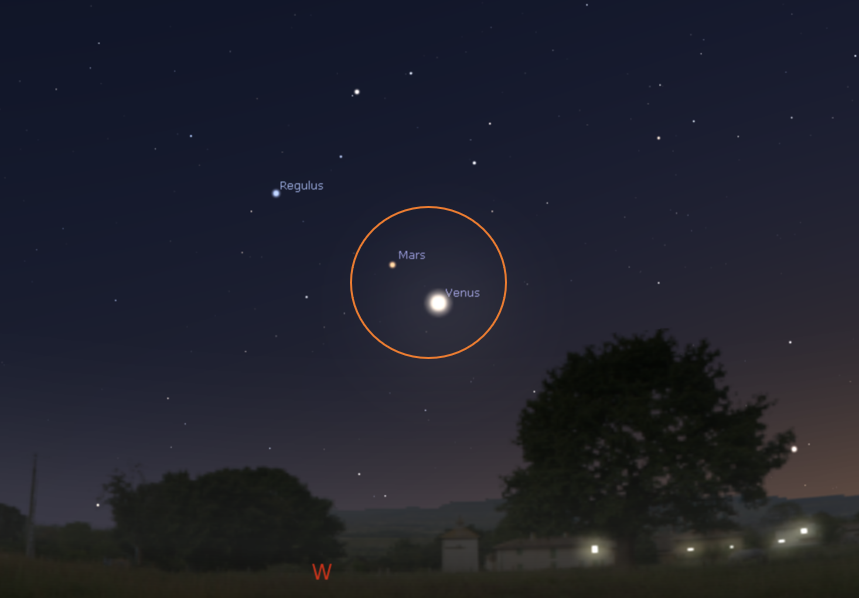What's Up: June 24 - July 1, 2023 - Jared May
What’s Up This Fourth Week of June
Unfortunately, it looks like a rainy and cloudy week ahead. There is hope that by Thursday the storms clear up giving way to clear night skies over the weekend of July 1st. The temperature during these clear nights will be in the 60s, so be sure to bring a jacket.
After waiting out the cloudy week, or perhaps during some breaks in the clouds, be on the lookout this week for the first quarter moon, Venus and Mars continuing to inch closer together, and a nearly full moon passing through Rho Ophiuchus. During the cloudy nights, spend some time classifying galaxies, or watching the real-time positions of several space probes.
Monday, June 26th, marks the first quarter moon. After Monday the moon will be passing through its gibbous phase during which more and more of the lunar surface gets revealed. During a full moon, it is quite easy to distinguish the lava seas and craters. Are you able to identify some of the famous craters when half the moon is hidden? On Tuesday, the day after the first quarter moon, most of the Tycho crater will be out from the shadow and visible. More realistically, however, you may just see the moon’s glow backlighting some overhead clouds.
The moon will be “First Quarter” on Monday, June 26.
Despite the planets orbiting the sun at tens of thousands of miles per hour, they appear to move very slowly in the sky. Similarly, a car moving at 60 mph close to you appears to move much faster than a car moving 60 mph that is far away – it is just an optical illusion. All week Venus and Mars (while zipping around the sun at 78,000 mph and 54,000 mph respectively) will be inching closer to each other. Separated by about three degrees in the sky, these two objects make great binocular or telescope targets.
Mars and Venus will inch closer this week. In reality, they are very far away from one another. Venus is on this side of the sun, while Mars is over on the other side. They are merely along the same line of sight.
On Friday, June 30th, the nearly full moon will have made its way into the constellation of Ophiuchus, which is home to the easily identifiable star, Antares (this star looks similar to Mars with its red/orange glow). Within this region is the Rho Ophiuchi cloud complex which hosts dark nebulae, emission nebulae, reflection nebulae, and even a tiny globular cluster right next to Antares. The bright moon will certainly wash all these features out, but it can point you to this region of the sky for the week ahead when the moon has moved on.
This image is what you would normally see in the Rho Ophiuchi region using a wide-angle camera lens, a DSLR camera, and several stacked two-minute exposures. The Moon will be in this region by the end of the week, washing out the view.
This is a more realistic approximation of what you will see when the moon passes through the Rho Ophiucus region.
During the inevitable multi-night event of cloudy skies this week, spend some time on the Galaxy Zoo website (https://www.zooniverse.org/projects/zookeeper/galaxy-zoo/) or track where Voyager and other space probes are in real-time (https://eyes.nasa.gov/). The Galaxy Zoo site shows you distant galaxies pulled from sky surveys that need to be classified. With just a few clicks you can specify if the galaxy you see is irregular, a spiral galaxy, face-on, interacting with a neighboring galaxy, and more! NASA’s real-time deep-space probe tracking site is great for visualizing the incredible distances at which some spacecraft, like Voyager and New Horizons, are by showing exactly what the probes see. You can even reverse time to see famous events, like when New Horizons passed by Pluto in 2015.
“Armchair Astronomy” is the practice of enjoying astronomy at home instead of out under the stars. Jared offers a couple of outlets for this above, including the “NASA Eyes” program, which tracks the positions of the planets and interplanetary spacecraft.
The forecast this week is not in stargazers’ favor, unfortunately. We can hope for some gaps in the clouds but ultimately the clouds will pass leading to some clear skies nearing next weekend. On those clear and warm nights, get outside and gaze upwards into the vastness of the cosmos. Let your imagination wander as you enjoy the first quarter moon, the meeting of planetary bodies, the nebulae in Rho Ophiuchi, classifying distant galaxies, and seeing what the most-distant manmade objects are seeing.
Clear Skies! (Hopefully?)




